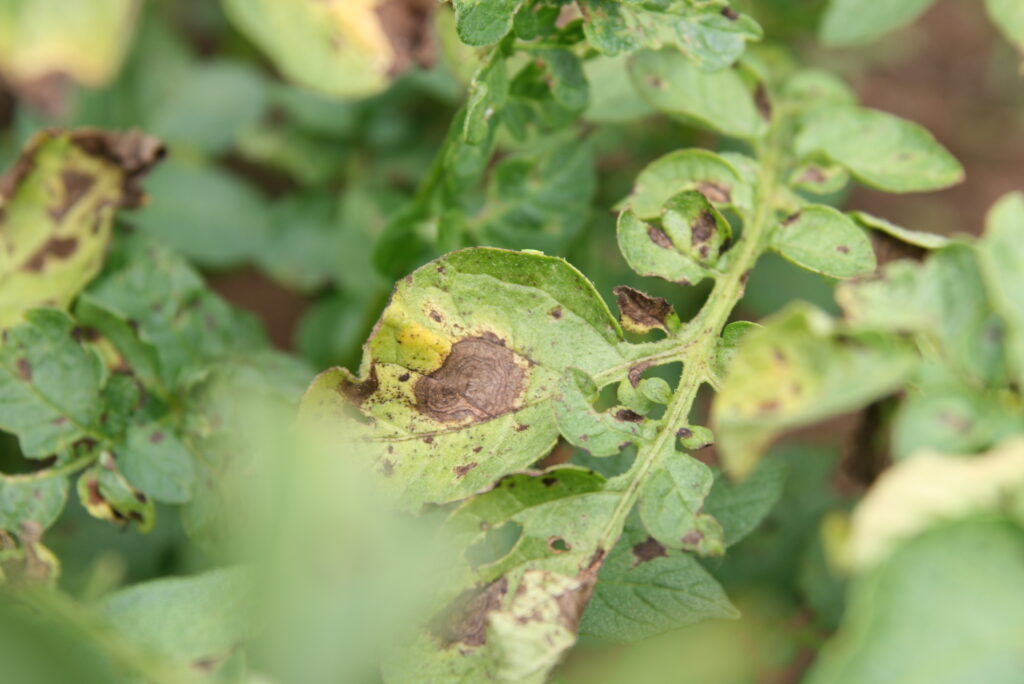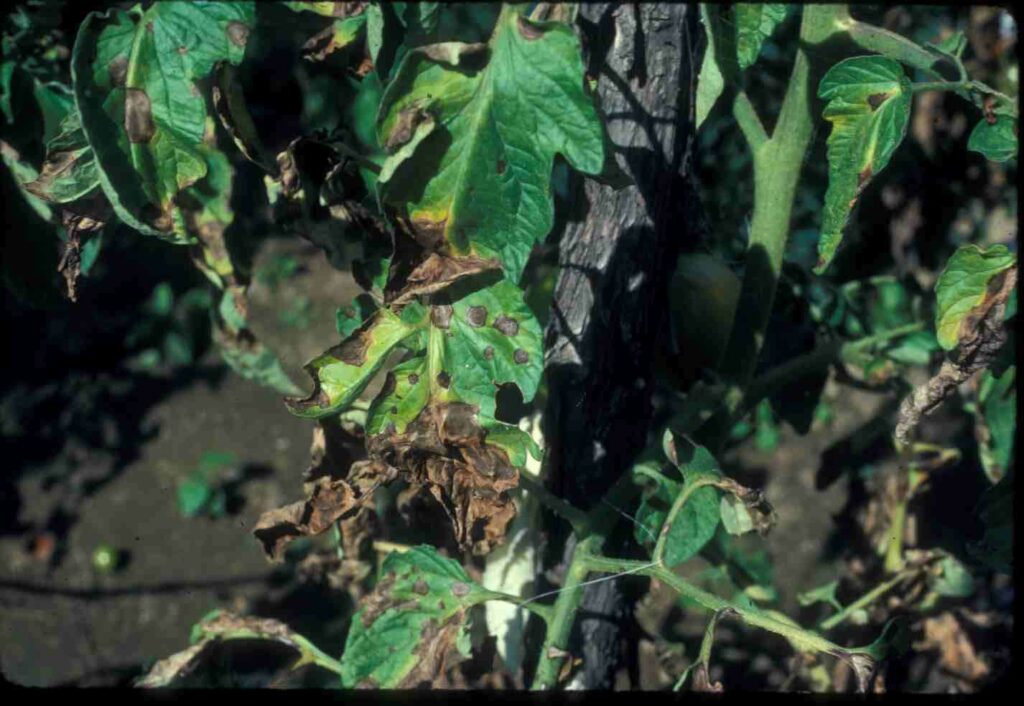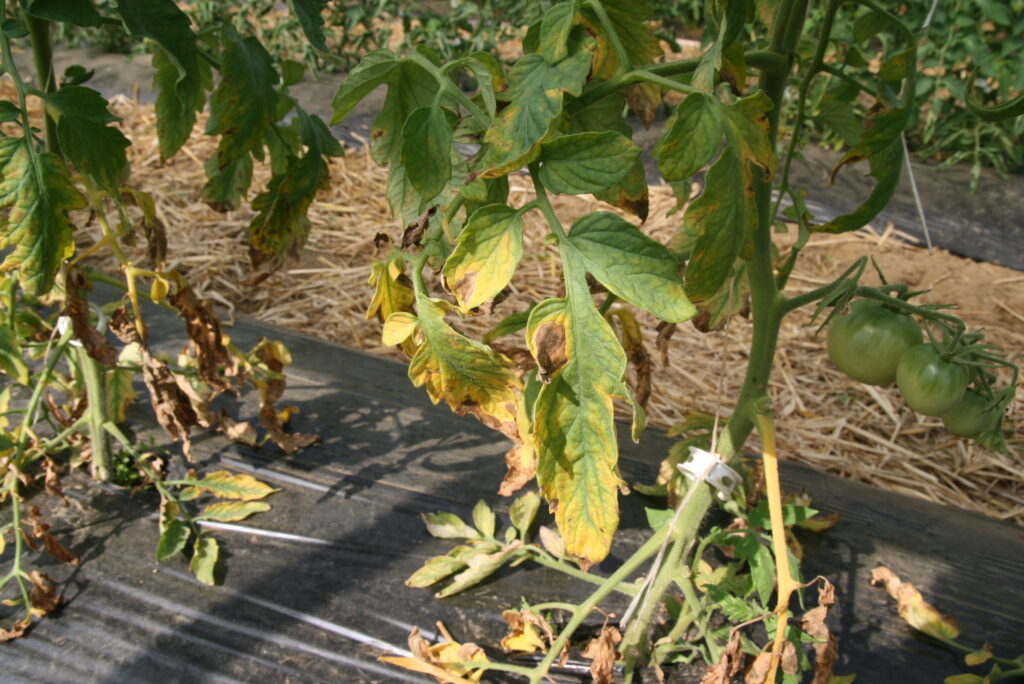
Disease: Early blight on tomato (Alternaria)
Pest/disease identification and lifecycle, most common damage symptoms and crops affected:
Early blight is a serious problem in tomatoes and potatoes, but rarely affects peppers and eggplants. In most years, it is very common; much more common than late blight, which is usually rare in Maine.

All aboveground portions of the plant can be affected throughout the growing season. The disease starts on the lower leaves with small, circular spots with concentric rings that resemble a target. Leaves develop yellow blighted areas, eventually turn all yellow and die. The tomato fruit may rot on the stem end. Though rare, potato tubers can also become infected.
The pathogen overwinters on diseased plant residues in the soil. Initial infection is from splashing up from this overwintering site. However, by mid-summer, most of the infection is coming from spores blowing in the wind from the widespread infection in gardens and on farms across the region.
It is important to avoid early on-set of the disease because the longer you can avoid the problem the more likely it is that you will harvest red tomatoes before the plants die. Vigorous tomato varieties, like many cherry tomatoes, can sometimes “outgrow” the disease.

Management options:
Cultural:
- Use crop rotations of at least three years to non-hosts (i.e., away from tomato, potato and eggplant). Once the plant residue decays, the pathogen is gone.
- Provide optimum growing conditions and fertility. Stressed plants (including drought or excessive moisture or shade) are more susceptible to early blight.
- Stake or cage plants to keep fruit and foliage away from soil, and promote quicker drying.
- Prune off the lower/older leaves to facilitate airflow (and to remove potential sources of early blight inoculum, as older leaves tend to be more susceptible to infection as they age and senesce and then may serve as a jumping off point for more spore production). Similarly, remove suckers as appropriate — typically all suckers from the base of the plant until just below the first flower/fruit cluster, where a particularly strong-growing sucker usually forms. You can let this one sucker grow as a “second leader” for the plant, but greenhouse growers often maintain only one primary leader. You can stop there for determinate (bush) tomato varieties; with indeterminate (vining) varieties you may want to continue suckering later on as the plant grows taller.
- Drip irrigation is preferred. If using overhead irrigation, start before dawn, so plants are dry early in the day. The key is to keep the period of leaf wetness to a minimum.
- Mulching helps to prevent splashing of spores from soil up to lower leaves.
- Indeterminate tomato and late-maturing potato varieties are usually more resistant or tolerant to early blight, and some varieties may have more resistance to early blight than others.
- Each season, disinfect stakes with an approved product before use. Many certified farmers choose hydrogen peroxide and peroxyacetic acid products, like SaniDate, though some sodium hypochlorite (bleach) products are allowed for use with rinsing and proper disposal, depending upon formulation. Sodium hypochlorite is effective in a 0.5% solution. Certified farmers should take care to check with their certification specialist that any product they use is approved, and added to their materials list.
- Grow tomatoes in a high tunnel or caterpillar tunnel. Tomatoes grown with such protection rarely suffer from early blight because there is less soil splashing, fewer wind-blown spores and the leaves remain drier.

Pesticides approved for use in certified organic production (as a last resort):
Any fungicide needs to be applied preventatively to be effective. Biofungicides may help prevent infection in years with lower disease pressure (drier summers), but copper products may be needed to protect uninfected plant sections if early blight presence and spore production is already high in the area, and weather conditions are conducive to its survival and spread.
Please note: This information is for educational purposes. Any reference to commercial products, trade or brand names is for information only, and no endorsement or approval is intended. Pesticide registration status, approval for use in organic production and other aspects of labeling may change after the date of this writing. It is always best practice to check on a pesticide’s registration status with your state’s board of pesticide control, and for certified organic commercial producers to update their certification specialist if they are planning to use a material that is not already listed on their organic system plan. The use of any pesticide material, even those approved for use in organic production, carries risk — be sure to read and follow all label instructions. The label is the law. Pesticides labeled for home garden use are often not allowed for use in commercial production unless stated as such on the label.
Source material attribution: Written by Eric Sideman, MOFGA crop specialist emeritus, and Caleb Goossen, MOFGA crop specialist.

